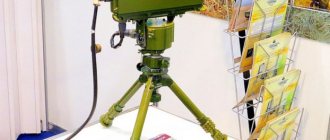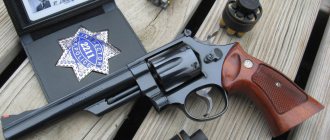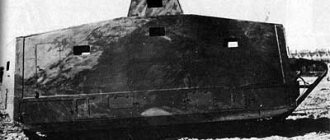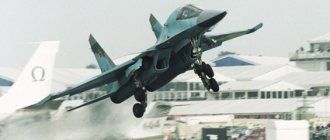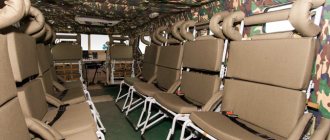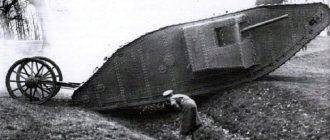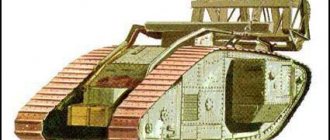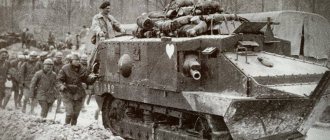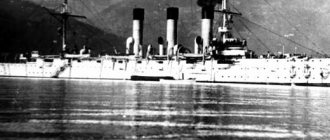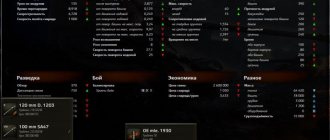In the next two years, the Ministry of Defense will receive more than 120 of the latest BMP-2M with the Berezhok module. This is enough to equip at least four motorized rifle battalions. It is expected that all the vehicles will be sent to the Western Military District, sources in the military department and the military-industrial complex told Izvestia. The new product is equipped with a whole arsenal of weapons - the Kornet anti-tank missile system, a machine gun, a 30-mm cannon and even an automatic grenade launcher. Also, the updated combat vehicle is equipped with the most modern optical-electronic systems, on-board computers and digital sensors. According to experts, now the BMP-2M with Berezhkom is the most powerful infantry fighting vehicle in the Russian Armed Forces.
First episode
According to the parameters of the contract, which Izvestia reviewed, by the end of 2022 the military department plans to receive 124 BMP-2M with the Berezhok module. The first batch of updated combat vehicles may arrive as early as 2020.
Shield and beam: infantry fighting vehicles will receive new protection and a powerful laser
The Ministry of Defense agreed to equip the BMP-3 with additional equipment
Formally, the BMP-2M is considered a deep modernization of the main infantry fighting vehicle of the Russian army, the BMP-2. But in fact this is a completely new technique. During the work, in addition to the Berezhok module (military designation BM B05YA01), new turbocharged engines will be installed on the updated vehicles, the suspension will be strengthened and the armor will be increased.
The modernization will be carried out by the Tula enterprise Shcheglovsky Val, which recently successfully completed a contract to equip Berezhkom with 360 Algerian BMP-1 and BMP-2 BMPs and built a separate workshop to fulfill orders from Russian aircraft.
So far the army has a batch of several dozen BMP-2M vehicles with the Berezhok module. Since 2022, they have been undergoing experimental military operation and final testing. It was this technique that was demonstrated at the parade in Moscow on June 24.
In May, the Ministry of Defense announced that by the end of the year the BMP-2M with the Berezhok combat compartment was planned to enter service with the troops, but did not specify the number of vehicles ordered.
The BMP-2M's combat characteristics have increased significantly, military expert Alexey Khlopotov told Izvestia. New sighting systems and thermal imaging devices have appeared. More modern and powerful missiles have been installed.
Sharpened the "Dagger": added intelligence to the latest heavy infantry fighting vehicles
The ammunition load of the T-15 infantry fighting vehicle will include high-precision and programmable artillery shells
“Before the battle, it was necessary to take a guided missile out of the fighting compartment, lean out and install it on the guide,” the specialist explained. — During the battle, the ammunition, being in a plastic container, was quite vulnerable. The modified version of the vehicle contains four installations of the latest Kornet missile with a tandem warhead. They penetrate equipment equipped with dynamic protection. The ammunition is protected from bullets and shrapnel by armored shields. And most importantly, they are connected to a fire control system. The updated BMP-2 has received a kind of long arm and can now knock out tanks at a distance of 5 km. Her search capabilities have improved. And the 30-mm automatic cannon was equipped with an all-weather sighting system.
With tandem cumulative warhead
| Anti-tank guided missile with a tandem cumulative warhead | |
| Damage range, m | 150-8000 |
| Armor penetration beyond range, mm | 1100-1300 |
| Rocket caliber, mm | 152 |
| Weight with container, kg | 31 |
| Container length, mm | 1210 |
Armed and very dangerous
According to the developers, the upgraded BMP-2M is twice as effective in combat effectiveness as the American Bradley, and the basic version of the BMP-2 is four times as effective.
This improvement was achieved by the Berezhok combat module, developed on the basis of a conventional BMP-2 turret. In addition to a 30-mm cannon and a tank machine gun, it now carries four missiles of the latest Kornet-E anti-tank system. In addition, an automatic grenade launcher has been added, capable of firing along hinged trajectories.
Kamchatka watchmen: new infantry fighting vehicles will cover strategic submarines
Combat vehicles are capable of hitting enemy equipment, manpower and even boats
Guided Kornets, depending on the modification, can hit ground and air targets at a distance of 5 to 10 km. Their armor penetration of 1200 mm of armor is enough to destroy any modern tank, even “head-on”, where its protection is strongest. It is also possible to overcome the latest active protection systems that shoot down ammunition on approach. To do this, “Berezhok” can fire two missiles at one target with a second interval. Even if the first one is intercepted, the second one will hit the target.
Unlike the Konkurs anti-tank missile system, which is standard for the BMP-2, the new missiles can be fired while moving. They are no longer limited by wires and are guided by a laser beam. If necessary, Kornets are capable of hitting low-speed air targets at low altitudes - helicopters and drones, as well as buildings. For this purpose, the arsenal contains not only armor-piercing, but also powerful thermobaric ammunition.
A 30mm automatic grenade launcher is much more effective than a BMP cannon for firing at infantry hidden in trenches or behind cover. With the new grenades, its maximum range reaches 2 km.
The commander and gunner have separate sights with night and thermal imaging channels. Weapons and surveillance devices are stabilized and can automatically keep the target in sight day and night, as well as while moving. A modern laser rangefinder determines the distance to it at a distance of 10 km.
Fighter demand: VKS will receive the latest missiles under a record contract
High-precision R-77-1 for medium-range air combat will cost 65 billion rubles
With thermobaric warhead
| Guided missile with thermobaric warhead | |
| Damage range, m | 150-10000 |
| Warhead TNT equivalent, kg | 7 |
| Target sensors | contact and non-contact |
| Rocket caliber, mm | 152 |
| Weight with container, kg | 33 |
| Container length, mm | 1210 |
The Kornet-EM complex can be easily mounted on a wide range of wheeled and tracked vehicles. The complex provides firing of all missiles of the Kornet-E family.
New equipment
At the Army 2020 forum, the BMP-2M with Berezhkom was exhibited with an additional protection kit installed. Lattice screens and mounted armor developed at the Steel Research Institute were mounted on it. They protect the body of the vehicle from bullets from large-caliber machine guns and allow you to repel grenades from RPG-7. The weight of such a kit is about one ton. It can be installed and dismantled by the crew.
The new turbocharged diesel UTD-23 is a third stronger than that installed on the version before modernization. Its power reaches 400 hp. Hydraulic shock absorbers with increased energy intensity and reinforced road wheels make it possible to cope with the increased weight of the better protected BMP-2M. Rubber-metal tracks last longer and cause less damage to roads.
Communication equipment has also been updated. The vehicles will receive a modern digital radio station R-168 “Aqueduct” with an increased range and improved communication quality. An important feature will be the ability to connect infantry fighting vehicles to modern automated combat control systems.
The contract for the BMP-2M with the Berezhok combat vehicle is only part of large-scale work to modernize the Ground Forces. Last December, it announced its intention to supply 565 armored vehicles to the Ground Forces, Airborne Forces and coastal forces in 2022. These include more than three hundred tanks, infantry fighting vehicles and armored personnel carriers. In the near future, it is planned to increase the amount of modern and modernized equipment in the Ground Forces to 70%. According to the military department, in 2022 this figure was 50%.
Our BMP is flying forward
Before dwelling on the details of the ongoing modernization, we will consider the topic of armored vehicles of the ground forces from a broad perspective. The production of wheeled armored vehicles began in our country on the eve of the First World War, and this year we celebrated the centenary of domestic tank building. Victory in the Great Patriotic War, the 75th anniversary of which was celebrated this year, came at a high price. In the period from June 22, 1941 to May 9, 1945, our troops lost 83,500 units of armored vehicles, with the production of 105,251 tanks and self-propelled guns - these are the highest figures among the countries participating in the Second World War.
In the post-war period, the Soviet Union confidently retained world leadership in tank production, but for a long time lagged behind the West in the production of armored personnel carriers. They decided to compensate for this lag qualitatively. The domestic military-industrial complex was the first to create a new class of armored vehicles - an infantry fighting vehicle. The BMP-1 was put into service in 1965. It, like an armored personnel carrier, also transported infantrymen inside an armored hull, but was distinguished by more powerful weapons and better protection.
© Photo from the archive The BMP-1 was put into service in 1965.
The BMP-1 received a 73 mm smoothbore "Grom" gun, and its improved version, the 1980 BMP-2, received a 30 mm automatic cannon, while contemporary armored personnel carriers were generally limited to machine guns. The frontal armor could withstand hits from 20-23 mm automatic cannon shells, and the side armor could withstand hits from a 12.7 mm machine gun.
True, after the advent of the next generations of ammunition, the security decreased somewhat, but, as the experience of local conflicts has shown, the BMP-1/2 can withstand shots from under-barrel grenade launchers, machine guns and 7.62 mm machine guns, and also protects against fragments of anti-personnel mines and hand grenades and mines of mortars of caliber up to 100 mm.
The Soviet Union produced more than 20 thousand BMP-1 and several thousand BMP-2, which is generally comparable to the production of tanks. Today our army has a similar number of infantry fighting vehicles/infantry fighting vehicles and tanks in combat units and at storage bases. The topic of their interaction on the battlefield remains as relevant as it was 55 years ago, when troops were just beginning to receive infantry fighting vehicles.
"Berezhok" of a promising river
The latest development of the Tula Instrument Engineering Design Bureau will allow the BMP-2 crew to destroy ground and air enemies day and night in any weather
The problem of modernizing BMP-2 infantry fighting vehicles in recent years has become very relevant not only for the Ground Forces of the Armed Forces of the Russian Federation, but also for the armies of other countries where these unpretentious mobile tracked vehicles are in service. But if the chassis, engine, etc. are still satisfactory to buyers and the Russian Ministry of Defense, then the weapons, sighting systems and communications equipment clearly require replacement.
As you know, “demand creates supply,” therefore, at the Defexpo 2014 international exhibition held in New Delhi, India in February of this year, the famous arms exporter RAFAEL (Israel) offered the Samson Mk II fighting compartment for the modernization of BMP-2 infantry fighting vehicles. In particular, Israeli developers claim that in addition to the new 30-mm cannon, their version provides for the possibility of installing anti-tank guided missiles, depending on the customer’s wishes. In addition, the Samson has fairly modern fire control and communication systems. It is noteworthy that RAFAEL chose to make its fighting compartment uninhabited, that is, the gunner-operator does not sit in the turret itself, but controls the weapon system remotely from the airborne compartment.
“The fire control system included a thermal imager, a range finder and a commander’s panorama - everything that the Russian military dreams of.”
If we look at the product catalogs of not only Israeli, but also Polish (in particular Grupa Bumar), Czech and other companies that manufacture weapons for the ground forces, then in their product lines one way or another there are options for upgrading the BMP-2, ranging from fairly budget, when it is more about restoring technical readiness than about full modernization, to projects with a serious increase in fire capabilities through the installation of new fire control systems, cannon and machine gun weapons, ATGMs, etc.
Of course, in the military and military equipment parks of many countries there are BMP-2 infantry fighting vehicles, which must not only be modernized, but also simply maintained in technical condition. But still, first of all, such offers are designed for sales on the international arms market. This is not surprising, since several thousand BMP-2s are in service in more than 40 countries around the world.
It must be said right away that Russian manufacturers not only keep up with their foreign competitors, but are also confidently leading in the modernization of the BMP-2. In particular, the Tula Instrument Design Bureau, part of the High-Precision Complexes holding, is presenting at the Oboronexport-2014 exhibition, which takes place from August 13 to 17 at the Zhukovsky airfield near Moscow, an updated fighting compartment for the BMP-2 with the rather playful name “Berezhok”. " Of course, compared to the background of “Needles”, “Strel”, “Shell”, “Typhoons”, etc., such a name seems frivolous, but despite this, the product of Tula gunsmiths is deservedly popular among foreign customers. Also, according to not only domestic but also foreign military experts, the Russian complex has no analogues in the world according to the “cost-effectiveness” criterion, which determines its great export success.
| Combat compartment "Berezhok" |
| Source: ARMS-TASS |
Old-new “twos”
Created in the early 80s, the BMP-2 is armed not only with the latest rapid-firing automatic 30-mm 2A42 cannon at the time, but also with a PKT machine gun, as well as anti-tank missile systems. True, the capabilities of the gunner's sight BPK 2-42 and the commander's (aka anti-aircraft) 1PZ-3 still left much to be desired. In particular, the BMP-2 had a rather weak night sighting channel, even by the standards of the early 80s, which used active infrared illumination of the target, which greatly unmasked the operation of the combat vehicle in night conditions. There was no full-fledged rangefinder, replaced by the so-called parabola, which consisted of marks of a certain height, combining with which the target, the commander or gunner-operator calculates the range using the “thousandths formula”. True, one should not blame Soviet designers who sought to simplify the BMP-2 infantry fighting vehicle as much as possible, since at that time the main enemy infantry fighting vehicles, in particular the German Marder, American M2 Bradley and English FV510 Warrior, were not much more perfect. In particular, only the US M2 had a thermal imager installed.
“I am very familiar with the BMP-3 and BMP-2 and can compare these two vehicles. It must be admitted that in modern conditions the algorithm for the work of the BMP-2 crew is a wild anachronism. The commander on the TKN-3B (commander’s observation device on the BMP-2. - Approx. A.R.) detects the target “using the formula of thousandths,” as we call it “blow in a thousand,” calculates the range in his head and gives target designation to the gunner, who On his sight he sets the range on a special scale. Moreover, there are three scales - for armor-piercing, high-explosive fragmentation shells for a cannon and separately for a machine gun. And only after that can you open fire. Even for a trained crew, this takes 20–30 seconds, and in fact, up to a minute, which in modern combat in a “duel” is almost certain death for our vehicle. The BMP-2 has neither a thermal imager nor a rangefinder, and the commander does not even have a normal “panorama”. And this is in comparison with modern fire control systems, where after detecting a target, not only the firing range, but also all corrections are automatically calculated, and the target tracking machine will lead the enemy to the last,” an officer passing service in the Southern Military District.
According to the interlocutor, the night channel of the sight exists rather for complacency, since it is very difficult to hit the target due to the imperfection of the device.
“It’s no secret that the militants in Chechnya had modern night vision sights. We captured one such night vision device in 2000, and imagine our surprise when we discovered that the infrared illumination of the target on the BMP-2 was visible from a very long distance. In fact, we couldn’t use it so as not to unmask our positions, but without an IR headlight on the BOD 2-42, let alone hitting the target, it’s even difficult to make out the contours of surrounding objects,” the deputy commander shared his memories with the Military-Industrial Courier one of the military units of the Western Military District.
But what causes the most criticism from the military is the sight of anti-tank guided missiles.
“The gunner-operator has to turn sideways, which is quite difficult to do in the cramped conditions of the BMP-2. The anti-tank missile control handles are also inconvenient. It is clear that for the 80s these were breakthrough solutions, but at the present stage - how inconvenient! And the complexes themselves – “Konkurs” or “Fagot”, installed on the BMP-2, depending on their series, are still not only morally, but also physically outdated,” an officer from the Southern Military District explained to the publication.
At the same time, all the officers who served on the BMP-2, who were interviewed by the Military-Industrial Courier newspaper, unequivocally stated that the BMP-2 infantry fighting vehicle is not only extremely reliable and unpretentious, but also has high maneuverability.
“The UTD-20S1 engine is quite powerful. The suspension provides high maneuverability. But the main thing is that the machine is easy to operate and, as we say in the troops, “foolproof,” that is, it forgives many mistakes and shortcomings in operation. In my subjective opinion, the BMP-2 is still less capricious than the BMP-3. If we installed new sights, rangefinders, thermal imagers, etc., then the prices for “twos” (the slang name for the BMP-2. - Note by A.R.) would not be there,” an officer of the Western Military-Industrial Complex admitted in a conversation with a VPK observer military district.
The opinion of their colleague was supported by all military personnel interviewed by the newspaper who were familiar with the operation of the BMP-2.
Looking for the golden mean
All these problems are known to the specialists of the Tula Instrument Design Bureau. In the late 90s, work began there on creating a combat module for modernizing the BMP-3. The result of the work was the Bakhcha-U BM. Subsequently, the Bakhcha-U BM was used as part of the newest BMD-4 airborne combat vehicle, but was tested on the BMP-2 and BTR-90 chassis, and was also adapted for installation on boats and surface ships. The weapon system (KB) of the Bakhcha-U BM is the next generation compared to the BMP-3 KB. The latest unified automatic fire control system (FCS) has been developed for it.
And yet, “Bakhcha-U” with two guns - 30-mm 2A70 and 100-mm 2A72, a modern sighting system with a rangefinder and a thermal imager reduces the BMP-2 landing party to five people. It is worth recalling that a conventional BMP-2 completely includes a motorized rifle squad (MSS), and when installing a BM, you have to reduce the number of military personnel in the MSO, which is unlikely, or look for another solution for the modernized vehicle.
It was first presented at the International Exhibition of Land Weapons held in 2006, and serial production has been carried out at KBP since 2007.
When developing the newest BO, Tula designers made a rather interesting decision: not to make the new module uninhabited. It is worth noting that this approach has drawn criticism from experts who claim that the manned fighting compartment is a serious step backwards, reducing the export attractiveness of the vehicle. But let's see how justified these claims are.
In order to reduce the vulnerability of the combat vehicle, the designers of the infantry fighting vehicles made them quite squat. Thanks to this silhouette, the vehicle is difficult to detect, but at the same time it imposes serious restrictions on the layout, forcing not only units, but also troops to be placed quite compactly. The gunner-operator (NO) and the vehicle commander sit in the BMP-2 turret, so if you install an uninhabited module, their jobs must be moved to another location. Taking into account the compactness of the BMP-2, this means that you will actually have to “throw out” two soldiers from the landing force. And taking into account the installation of the necessary components and assemblies, it becomes necessary to eliminate one more place.
Let us remember that the troop compartment is not a single space, but two compartments separated by a fuel tank. Therefore, when reworking it, it will have to be changed, which entails an inevitable transformation of the entire fuel system of the combat vehicle.
With such an “upgrade” of the design, there is no longer any talk about a budget modification of the vehicle, when only the standard turret is changed, instead of which a new fighting compartment is installed. It is necessary to actually redesign the troop compartment, fuel tanks, etc., which, naturally, will lead to a significant increase in the amount of the entire order.
It is worth noting that the designers of the RAFAEL company followed this path on their Samson-2 module, and this, as expected, led to a reduction in places in the landing force. It is noteworthy that in the specially made windows on the BMP-2 demonstration model with the Samson installed, it is clearly visible: for the convenience of the gunner-operator and commander, whose seats are located in the troop compartment, it was necessary to “cut down” the fuel tank. It is unclear how this affected the vehicle’s range, although the Israelis themselves admit that after installing the Samson, we are not talking about an infantry fighting vehicle, but rather about a fire support vehicle during counter-insurgency operations.
So, what advantages does Berezhok have?
For the BM, the hardware of the standard BMP-3 was used, well mastered by the “serial” ones: an armored cap, power systems for the automatic gun and PKT, a suspended floor, guidance gearboxes, etc. An automatic control system was installed, unified with the control system of the BM “Bakhcha-U” "and adapted for controlling container-launched ATGMs.
The fire control system included a thermal imager, a range finder, and most importantly, a commander’s panorama, that is, everything that the Russian military dreams of. If we compare the capabilities of the fire control system of the Russian combat compartment, we must admit that in a number of indicators it is superior to similar systems of the Russian BMD-4, the American M2A3 Bradley infantry fighting vehicle and the German Puma. And if we compare it with the control systems installed on the domestic BMP-3, English Warriors and German Marders, then the BMP-2 with Berezhkom significantly surpasses them in its capabilities.
The weapons also underwent changes. In particular, Tula designers left the 30-mm 2A42 automatic cannon and the PKT machine gun, but at the same time expanded the capabilities of hitting hidden tank-dangerous manpower (TZHS) in urban areas, vegetation and field fortifications by installing an AG-30M automatic grenade launcher. And most importantly, the Konkurs and Fagot anti-tank missile systems have been replaced by modern Kornet-E. It is noteworthy that the ATGM launchers are located on the sides of the turret and do not require reloading, as was the case on the old BMP-2.
Compared to the Berezhok BM, first shown in 2006, the modern model presented at the Oboronexport-2014 exhibition is capable of hitting targets with all modifications of the Kornet missile launcher at ranges of 5.5, 8 and 10 kilometers day and night, from a standstill and on the move, including afloat.
It is significant that, according to regulatory documents, the BMP-2 is capable of fighting low-flying air targets - airplanes and helicopters. Previously, the 2A42 cannon was used for this, and for such shooting a special mode was introduced in the fire control system, which can be selected by the commander at whose workplace the anti-aircraft sight is installed on the remote control switch (called “Cheburashka” in military slang). It is clear that access to 1PZ-3 in this case is so difficult that the troops prefer not to use it at all.
We must admit: in modern combat conditions, shooting at air targets, not to mention shooting them down, using the BMP-2 weapon system is quite problematic. In the Berezhok BM, the effectiveness of firing at low-flying targets approaches the level of specialized anti-aircraft weapons. Firing is ensured in automatic mode using a laser rangefinder, automatic tracking, and an original algorithm of a digital ballistic computer. One of the upgrades of the Kornet missile launcher has a high-explosive warhead with a non-contact target sensor (NDS).
We can safely say that with the Berezhka installation, with minimal modifications, the BMP-2 does not lose its excellent driving characteristics and ability to swim, but receives fire control systems, weapons and communication and navigation systems at the level of modern infantry fighting vehicles such as BMD-4, M2A3 Bradley ", "Puma".
“Berezhok” is a fairly budget option, when for minimal money the customer significantly increases the combat properties of the vehicle. It must be admitted that Israeli, Czech, Polish and other modernization options are much more expensive. Yes, the Czech Republic has modernized some of its BMP-2s, but this is quite expensive and only for the needs of its army,” independent military expert Alexey Khlopotov told VPK.
Back in 2005, a fairly expensive contract was signed to modernize 400 infantry fighting vehicles to the BMP-2M level with the installation of a Berezhok fighting compartment. In addition to installing BO, faulty components and assemblies, engines, etc. are replaced on machines.
But this contract turned out to be not the only one for KBP and the High Precision Systems holding. Thus, according to KBP Deputy Managing Director Yuri Khozyainov, interest in Berezhok has recently increased significantly after the Tula enterprise signed a large contract with foreign customers for its supplies.
“A large contract, designed for four years, was signed in October 2013. Therefore, the production line is busy,” said Yuri Khozyainov, refusing, however, to name the customer, the cost of the transaction and any other parameters of the contract.
The Tula Instrument Design Bureau and the High Precision Complexes holding were able to find the optimal solution for modernizing the proven BMP-2. The designers have found that golden mean when the cost-effectiveness ratio makes Berezhok very popular among buyers and attracts the attention of new customers.
Let's hope that the KBP will not stop there and will continue to produce and develop unique combat compartments and modules.
Alexey Ramm
Published in issue No. 29 (547) on August 13, 2014
BMP-1 USSR vs M-113 USA: who wins?
A comparison of the BMP-1 and the American M-113 armored personnel carrier, which entered service in 1960 and is still produced in various modifications, is instructive. With a mass of 13 tons, only 6% more, our vehicle was distinguished by the presence of a turret with a 73-mm cannon and a coaxial 7.62-mm machine gun, while the American one carried only a 12.7-mm Browning. The hull was welded from high-hardness rolled steel armor, and the Americans, in order to reduce weight, often used aircraft-grade aluminum.
© army.mil
The American M-113 armored personnel carrier entered service in 1960.
As a result, the BMP-1 turned out to be much more resistant to small arms fire from the rear and side, and in the frontal projection, also thanks to the rational angles of the armor plates, from heavy machine guns. Mobility was approximately equal due to the use of a tracked chassis and a diesel engine (ours is 9% more powerful). The only thing in which the M-113 was superior was the number of troops it carried: two crew members plus eleven infantrymen versus three and seven to eight, respectively.
It is important to understand: the BMP-1 and M-113 are made at approximately the same technological level. The difference in tactical and technical characteristics and weapons comes from belonging to different classes of armored vehicles.
Soviet military doctrine provided for large-scale offensive operations by tank and motorized rifle formations, and numerous BMP-1s were supposed to operate in a single deployed formation with tanks.
The design of the latter allowed transported motorized riflemen to fire from machine guns while inside the armored hull. The M-113 does not have this option. It was intended only to transport infantry to the battlefield and support it with fire while dismounting. Immediately after this, the armored personnel carrier retreated back, firing back from a 12.7 mm machine gun. Its creators did not think about any joint actions with tanks, like the BMP-1.
The Pentagon announced its desire to completely get rid of the M-113 by 2030 due to the exhaustion of development and modernization potential. The Russian military department acted differently in relation to the BMP-1. The vehicle will remain in service for a long time thanks to modifications to the BMP-1AM “Basurmanin” variant.
